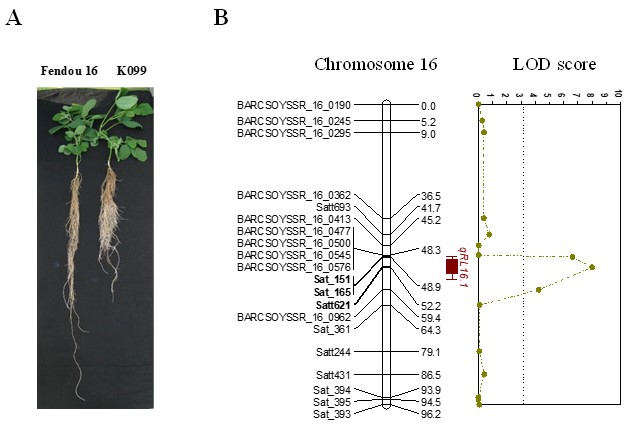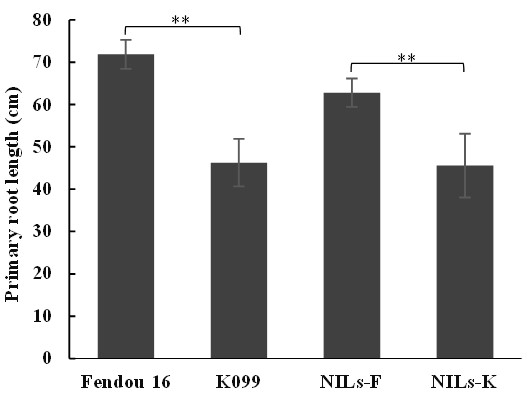Identification and validation of a major QTL for primary root length in soybean
Description
The root system absorbs water and nutrients, which are essential for plant growth, from the soil. The phenomenal formation of a robust and extensive root system is extremely important in crop plants because it ensures their adaptability to the surrounding environment and their improved resource acquisition in the low input environment. However, roots are the hidden part of plants and have high adaptive plasticity in various environments. Therefore, the characterization of the root system requires considerable efforts in field conditions. The large variation observed in root traits suggested that the improvement of soybean by the genetic alteration of root traits is feasible. In this study, genetic analysis was conducted with an aim to identify quantitative trait loci (QTL) associated with primary root length (PRL) in soybean.
A total of 103 F7 recombinant inbred lines (RILs) derived from a cross between “K099” (short primary root) and “Fendou 16” (long primary root) were used to identify QTL for PRL. “Fendou 16” is a soybean cultivar from Shanxi, China, and “K099” is a Korean soybean cultivar. Linkage groups were constructed with 223 simple sequence repeat markers from the 20 chromosomes. Phenotyping for PRL was performed in hydroponic conditions. QTL analysis identified a major QTL (qRL16.1) on chromosome 16 between SSR markers Sat_165 and Satt621, explaining 30.25% of the total phenotypic variation (Fig. 1). The effect of qRL16.1 was confirmed using qRL16.1 near-isogenic lines (NILs). PRL was significantly longer in NILs possessing the qRL16.1 allele of “Fendou 16” compared to allele of “K099” (Fig. 2). In addition, to validate qRL16.1 in a different genetic background, QTL analysis was performed in another F6 RIL population derived from a cross between “Union” (medium primary root) and “Fendou 16,” in which a major QTL was detected again in the same genomic region as qRL16.1, explaining 14% of the total phenotypic variation for PRL.
qRL16.1 is a novel QTL for primary root length in soybean which provides important information for understanding the genetic control of root development. Identification of this major QTL will facilitate positional cloning and DNA marker-assisted selection for improvement of root traits in soybean.
Figure, table
-
Fig. 1. The primary root length QTL (qRL16.1) detected on chromosome 16 in the RIL population derived from a cross between “K099” and “Fendou 16”
(A) Comparison of root architecture between “Fendou 16” and “K099” grown in hydroponic conditions. (B) Position and LOD score of the primary root length QTL (qRL16.1). -
Fig. 2. Effect of the qRL16.1 allele on primary root length of two near isogenic lines, NILs-F and NILs-K
NILs-F: “Fendou 16” genotype; NILs-K: “K099” genotype. Error bars indicate SD (n = 8). **: P < 0.01.Figures reprinted/modified with permission from Chen et al. (2021).
- Classification
-
Research
- Research project
- Program name
- Term of research
-
FY 2016–2020
- Responsible researcher
-
Xu Donghe ( Biological Resources and Post-harvest Division )
Chen Huatao ( Jiangsu Academy of Agricultural Sciences, P.R. China )
Kumawat Giriraj ( ICAR-Indian Institute of Soybean Research, India )
Yan Yongliang ( Xinjiang Academy of Agricultural Sciences, P. R. China )
Fan Baojie ( Hebei Academy of Agricultural and Forestry Sciences, P. R. China )
- ほか
- Publication, etc.
-
Chen H et al. (2021) BMC Genomics, 22:132https://doi.org/10.1186/s12864-021-07445-0
- Japanese PDF
-
2021_B01_ja.pdf277.89 KB
- English PDF
-
2021_B01_en.pdf165.52 KB
- Poster PDF
-
2021_B01_poster.pdf246.21 KB
* Affiliation at the time of implementation of the study.


